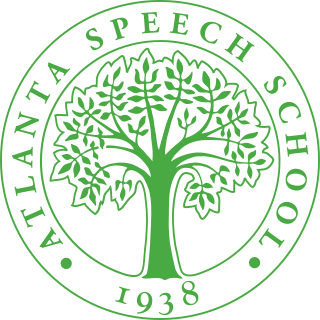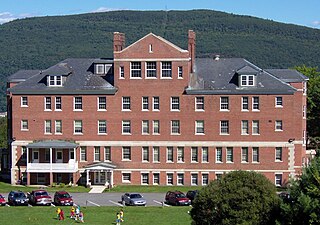Oralism is the education of deaf students through oral language by using lip reading, speech, and mimicking the mouth shapes and breathing patterns of speech. Oralism came into popular use in the United States around the late 1860s. In 1867, the Clarke School for the Deaf in Northampton, Massachusetts, was the first school to start teaching in this manner. Oralism and its contrast, manualism, manifest differently in deaf education and are a source of controversy for involved communities. Listening and Spoken Language, a technique for teaching deaf children that emphasizes the child's perception of auditory signals from hearing aids or cochlear implants, is how oralism continues on in the current day.
Oregon Health & Science University (OHSU) is a public research university focusing primarily on health sciences with a main campus, including two hospitals, in Portland, Oregon. The institution was founded in 1887 as the University of Oregon Medical Department and later became the University of Oregon Medical School. In 1974, the campus became an independent, self-governed institution called the University of Oregon Health Sciences Center, combining state dentistry, medicine, nursing, and public health programs into a single center. It was renamed Oregon Health Sciences University in 1981 and took its current name in 2001, as part of a merger with the Oregon Graduate Institute (OGI), in Hillsboro. The university has several partnership programs including a joint PharmD Pharmacy program with Oregon State University in Corvallis.

Pre-kindergarten is a voluntary classroom-based preschool program for children below the age of five in the United States, Canada, Turkey and Greece. It may be delivered through a preschool or within a reception year in elementary school. Pre-kindergartens play an important role in early childhood education. They have existed in the US since 1922, normally run by private organizations. The U.S. Head Start program, the country's first federally funded pre-kindergarten program, was founded in 1967. This attempts to prepare children to succeed in school.
NextSense, formerly the Royal Institute for Deaf & Blind Children (RIDBC), in Sydney provides a range of educational services for students with vision and/or hearing impairment, including specialist schools for signing deaf students, oral deaf students, and students with sensory and intellectual disabilities.

Mainstreaming, in the context of education, is the practice of placing students with special education needs in a general education classroom during specific time periods based on their skills. This means students who are a part of the special education classroom will join the regular education classroom at certain times which are fitting for the special education student. These students may attend art or physical education in the regular education classrooms. Sometimes these students will attend math and science in a separate classroom, but attend English in a general education classroom. Schools that practice mainstreaming believe that students with special needs who cannot function in a general education classroom to a certain extent belong in the special education environment.

The Children's Center for Communication/Beverly School for the Deaf (CCCBSD) is a school, established in 1876, for students from birth to age twenty-two who are Deaf, Hard-of-Hearing, or hearing with complex communication needs by providing language that is visually accessible via American Sign Language, written English, speech, and AAC/Assistive Technology.

The American School for the Deaf (ASD), originally The American Asylum, At Hartford, For The Education And Instruction Of The Deaf, is the oldest permanent school for the deaf in the United States, and the first school for deaf children anywhere in the western hemisphere. It was founded April 15, 1817, in Hartford, Connecticut, by Thomas Hopkins Gallaudet, Mason Cogswell, and Laurent Clerc and became a state-supported school later that year.

The North Dakota School for the Deaf (NDSD) is a state-funded residential school located in Devils Lake, North Dakota that provides services to meet the educational needs of children who are deaf and hard of hearing. NDSD is under the direction, control, and management of the North Dakota Department of Public Instruction. The current superintendent of the school is Donna Sorensen.

The Atlanta Speech School is a language and literacy school located in Atlanta, Georgia, established in 1938. The school provides educational and clinical programs. The Atlanta Speech School's Rollins Center provides professional development for teachers and educators in partner schools and preschools. The Rollins Center focuses on the eradication of illiteracy. The Rollins Center has an online presence called Cox Campus, which is an online learning environment with coursework targeted for the education of children age 0–8.

The Austine School for the Deaf, now closed, in Brattleboro, Vermont, was an independent, coeducational day and residential school for deaf and hard-of-hearing children age four to eighteen from New England and New York.

Deaf education is the education of students with any degree of hearing loss or deafness. This may involve, but does not always, individually-planned, systematically-monitored teaching methods, adaptive materials, accessible settings, and other interventions designed to help students achieve a higher level of self-sufficiency and success in the school and community than they would achieve with a typical classroom education. There are different language modalities used in educational setting where students get varied communication methods. A number of countries focus on training teachers to teach deaf students with a variety of approaches and have organizations to support and advocate for deaf students.

Portland, Oregon contains six public school districts, many private schools, as well as public and private colleges and universities including Portland State University.
Iowa School for the Deaf is a pre-K to 12th grade school for deaf and hard-of-hearing students located in Council Bluffs, Iowa. It serves students who live in Iowa and Nebraska.
The history of deaf education in the United States began in the early 1800s when the Cobbs School of Virginia, an oral school, was established by William Bolling and John Braidwood, and the Connecticut Asylum for the Deaf and Dumb, a manual school, was established by Thomas Hopkins Gallaudet and Laurent Clerc. When the Cobbs School closed in 1816, the manual method, which used American Sign Language, became commonplace in deaf schools for most of the remainder of the century. In the late 1800s, schools began to use the oral method, which only allowed the use of speech, as opposed to the manual method previously in place. Students caught using sign language in oral programs were often punished. The oral method was used for many years until sign language instruction gradually began to come back into deaf education.

The Deaf rights movement encompasses a series of social movements within the disability rights and cultural diversity movements that encourages deaf and hard of hearing to push society to adopt a position of equal respect for them. Acknowledging that those who were Deaf or hard of hearing had rights to obtain the same things as those hearing lead this movement. Establishing an educational system to teach those with Deafness was one of the first accomplishments of this movement. Sign language, as well as cochlear implants, has also had an extensive impact on the Deaf community. These have all been aspects that have paved the way for those with Deafness, which began with the Deaf Rights movement.

Nagoya International School (NIS) is a private non-sectarian day international school in Nagoya, Aichi, Japan. Instruction is in English. The co-educational school serves students in preschool through high school. Graduates earn a standard NIS diploma or an International Baccalaureate diploma. Nagoya International School was opened in 1964 partly in response to the demand for English-language instruction post World War II. The curriculum of Nagoya International School was initially based on the curriculum of American schools, but, over the years, the curriculum has been redesigned to be more international. The school is open to students of all backgrounds who can demonstrate the ability to succeed in an English-language school.
Co-enrollment is an instructional approach that brings deaf or hard of hearing students and hearing students together in a classroom. It is distinguished from mainstreaming approaches in several ways and more closely follows bilingual and dual language education practice and goals. In the 1960s and 1970s, many schools for the deaf in Scandinavia moved from an oral approach to a bilingual model. During the 1980s, many schools for the deaf in the United States began implementing bilingual curriculum under a bilingual-bicultural education model. During the 1980s and 1990s, this model was widely adopted around the globe. Co-enrollment extends the bilingual educational approach to include hearing students as well, with varying emphasis on Deaf culture. Programs following this model provide all students with access to signed, spoken and written language.
The Governor Baxter School for the Deaf (GBSD), formerly known as the Maine School for the Deaf is a public co-educational school that serves the deaf and hard-of-hearing in the State of Maine. It is located on Mackworth Island, an approximately 100-acre (40 ha) island in Falmouth, Maine, USA, adjacent to its border with Portland, Maine. Students who live far away may stay with host families, who provide residential services. Its program is the Maine Educational Center for the Deaf and Hard of Hearing (MECDHH).
Dr. Laurene Simms is a Deaf American educator and advocate. She is the Chief Bilingual Officer at Gallaudet University. In 2000, she became the first Black alumna from the Indiana School for the Deaf to earn a doctorate.
Though official statistics are not available, the Danish Deaf Association estimates that there are currently about 5,000 deaf users of Danish Sign Language, which is equivalent to nearly 0.1% of the country's population. As many as 20,000 people are thought to use the language daily in their professional or personal life.











